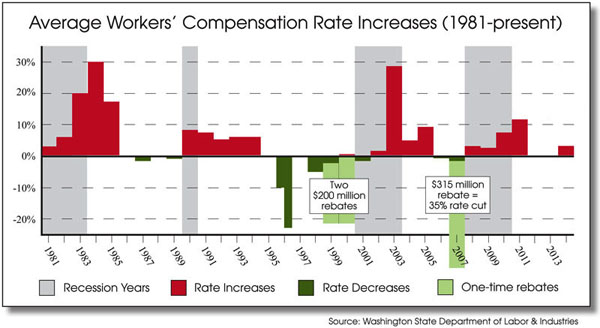STATE GOVERNMENT
State workers’ comp system posts strong gains, L&I reports
By DAVID GROVES
The Stand
 OLYMPIA (April 18, 2014) — The Washington State Department of Labor and Industries reported April 4 that the financial condition of state-run workers’ compensation system continues to recover steadily from the recession. L&I says that the system’s net operations income grew by $191 million in the second half of 2013, while contingency reserve funds grew by $421 million to a total of more than $1 billion. L&I attributed the strong performance to higher-than-expected investment earnings and lower-than-expected pension and time-loss claims by injured workers.
OLYMPIA (April 18, 2014) — The Washington State Department of Labor and Industries reported April 4 that the financial condition of state-run workers’ compensation system continues to recover steadily from the recession. L&I says that the system’s net operations income grew by $191 million in the second half of 2013, while contingency reserve funds grew by $421 million to a total of more than $1 billion. L&I attributed the strong performance to higher-than-expected investment earnings and lower-than-expected pension and time-loss claims by injured workers.
The sustained post-recession improvement in the system’s finances coincides with a loss of legislative momentum in 2014 for expanding the state’s controversial “compromise-and-release” lump-sum buyouts program, which has failed to save as much money as advertised. This year, legislation to remove the age restriction on the lump-sum buyouts was approved 27-22 in the Republican-controlled Senate — getting three fewer votes than it had the previous year — before being rejected again by the Democratic-controlled House.
Advocates for injured workers oppose the buyouts, which allow employers to settle claims of injured workers over age 55 (dropping to age 50 in 2016) with lump-sum payments that are less than what they would otherwise receive. Because the buyouts are negotiated when families are facing extreme financial hardship due to loss of income, struggling families — especially those of younger workers — can’t anticipate their future expenses and may agree to buyouts for pennies on the dollar that aren’t in their long-term financial interests.
Proponents of the settlements have argued that such cost-saving “reforms” are necessary to avoid dramatic rate increases and to build up the system’s reserves, which were depleted during the recession.
After the recession pummeled the system’s investments, the State Auditor warned in 2010 that reserves were precariously low, leading some to predict dramatic rate increases. In 2011, the Legislature responded by approving several changes in the workers’ compensation system, including legalizing the lump-sum buyouts for older workers. But since then, the promised cost savings have failed to materialize as fewer workers than anticipated agreed to accept buyouts. In 2013, L&I had to transfer $242 million out of reserves to cover the shortfall in projected savings from the buyouts.

Meanwhile, as the state economy has steadily recovered, the workers’ compensation system’s financial performance has improved — without any dramatic increases in the rates charged to employers and workers. There was no average rate increase at all in either 2012 or 2013. This year, the state approved a modest 2.7% increase intended avoid the unpredictable rate spikes of years past (note the rate spikes on the chart above following every economic downturn), while also helping rebuild system reserves to safer levels.
L&I Director Joel Sacks said this year’s increase is “part of a long-term plan to ensure steady and predictable rates, help injured workers heal and return to work, and reduce costs by improving operations.”
The system’s strong financial results reported this month occurred before the 2.7% average rate increase took effect on Jan. 1, 2014.





